Gold Nanostructures: Properties and Applications
Christian Schoen, Ph.D
President - Nanopartz, Inc.
Gold Nanorods
Functionalized Gold Nanorods
Gold Nanowires
Microgold
Platinum and Palladium Coated Gold Nanostructures
Introduction
Gold nanostructures have been extensively studied in a variety of applications due to their interesting electrical, conductive and optical properties. However, the use of these materials has recently expanded beyond traditional applications to include exciting functions in the biomedical, diagnostic and catalytic arenas.
- High Technology Electronics: Gold nanowires can replace carbon nanotubes in modern touchscreen displays.
- Catalysis: Platinum and palladium nanoparticle for catalytic applications to reduce the overall metal used by over one thousand times.
- Biomedical: In-vivo photothermal cancer therapy as well as cytosomal uptake of drug loaded gold nanoparticles for DNA therapy.
- Biodiagnostics: Biosensors and multi-channel lateral flow assays can be developed for quantitative multi-analyte detection
Gold Nanorods
During the last 20 years, spherical gold nanoparticles have been used to research photothermal cancer therapies. However, they were not optimized because spherical gold nanoparticles have limited peak absorptions (maximum ~580 nm for 100 nm diameter particles) which fall below the transmission window of 650 – 900 nm for biological entities (skin, tissue and hemoglobin). Gold nanorods behave similarly to the gold nanoparticles, but are elongated to optimize their peak absorption and scattering characteristics (Figure 1). This allows the ability to tune the nanorod absorption from 550 nm to 1400 nm through different manufacturing processes as shown on the right in Figure 1. This tuning results in the ability of gold nanorods to scatter at wavelengths across the visible and near-IR regions. The surface plasmon resonance (SPR) value is a measure of surface electromagnetic waves that travel in a direction parallel to metal/solvent interface and is heavily influenced by any material that is adsorbed onto the metal surface or to the surface of metal nanoparticles. Very accurate absorption values for metal nanostructures can be achieved by measuring the SPR values at a range of wavelengths (Figure 1).
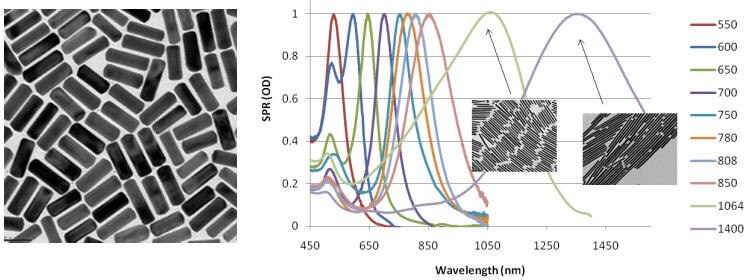
Figure 1. Left: TEM image of typical gold nanorods (10 nm x 40 nm) (Product No. 716820). Right: Gold nanorod peak absorption and scattering (extinction) can be tuned across the visible and near IR spectra shown on a plot of Surface Plasmon Resonance (SPR) to Wavelength.
Gold nanorods are also being used to enhance in-vivo imaging using photoacoustics and highly efficient non-linear optics such as four wave mixing. Researchers at the Centre for Micro-Photonics at the Swinburne University of Technology, Victoria, Australia are using these materials as polarizers (Figure 2) and have been able to improve the storage capabilities of DVDs by over 2,000 times.
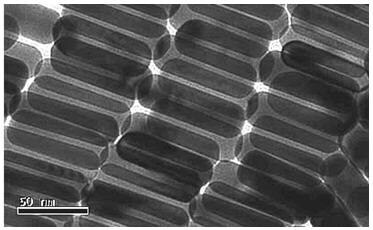
Figure 2. TEM image of gold nanorods used as polarizing materials.
Functionalized Gold Nanorods
Sigma-Aldrich Materials Science also offers a variety of functionalized gold nanorods, with functionalities including methyl (716901), amine (716871) and carboxyl (716898) terminal groups. The amine and carboxyl terminated nanorods are especially useful for the conjugation of a variety of biomolecules including proteins, antibodies and even DNA.
In the visible region, they can be used for multichannel lateral flow assays, and in the near IR region, they can be injected intravenously where they can aggregate in tumors. Once they are concentrated around the diseased cells, they can be subjected to a continuous wave near-infrared laser in order to generate heat for photothermal cancer therapy. The diagnosis characteristics of gold nanostructures (also as drug delivery vectors) can be concurrently used to destroy cancer cells (therapy) using pulsed lasers. This combination of diagnostics merged with therapy is termed theranostics. (Figure 3).
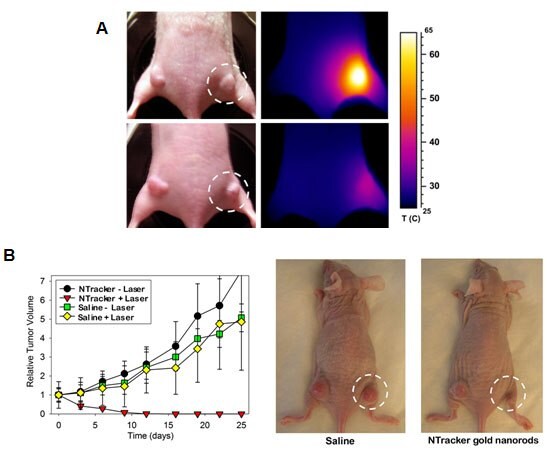
Figure 3. A) Photothermal cancer therapy in mice using gold nanorods and an external diode laser to heat and destroy the cancer cells (courtesy of Nanopartz, Inc.). B) Ablation of cancer cells using pulsed near infrared laser and gold nanorods (courtesy of Nanopartz, Inc.).
Gold Nanowires
Gold nanowires that are 30 nm axially and up to 20 microns in length are finding use as an alternative or complimentary material to carbon nanotubes. They are highly conductive, more transparent, and unlike silver nanowires, are resistant to corrosion or oxidation. Nanowires have shown to be useful as a carbon nanotube replacement in touchscreen displays and transparent electrodes (Figure 4). Gold nanowires have also shown promise when used as highly sensitive electronic biosensors.
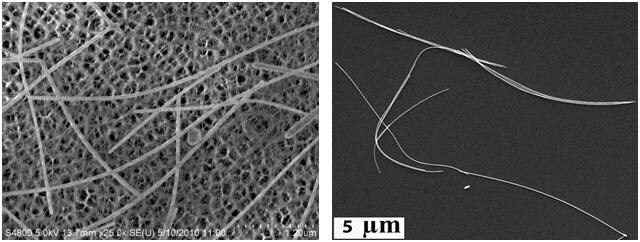
Figure 4. Left: TEM image of gold nanowires (Product Nos. 716944 and 716952) on a carbon nanotube framework. Right: SEM image of gold nanowires that can be used as a carbon nanotube replacement in organic electronics applications.
Microgold
With dimensions that are hundreds of nanometers wide and up to 1 micron in length, Microgold is the largest possible particle that can still be termed a nanoparticle. Since nanoparticle dimensions govern absorption properties, this unique material exhibits unique optical properties. Microgold (716960), is the first gold particle that can be seen under white light microscopy using conventional optics at single particle sensitivities (Figure 5). It is also the first particle known that, with a proprietary polymer coating, can be endocytosed into the cytosome of cells (Figure 5). This is of key importance in cell therapies where one would like to avoid uptake by cell liposomes.
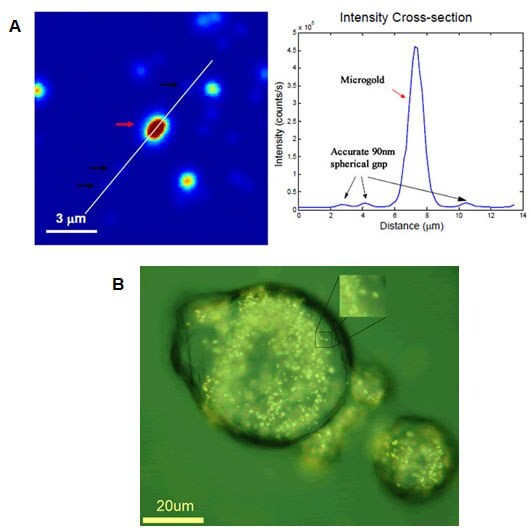
Figure 5. A) Microgold (Product No. 716960) used for single particle measurements in light microscopy (courtesy of Dr. Stephan Link, Rice University). B) Microgold used for cytosome uptake in cancer cell for drug delivery (courtesy of Dr. Eugene Zubarev, Rice University).
Platinum and Palladium Coated Gold Nanostructures
As we have seen above, decreasing the size of gold structures to the nanoscale offers enhanced behaviors from electrical to biomedical applications. However, at a very basic level, decreasing the size also dramatically increases the surface area, which makes nanomaterials interesting for use in catalysis. Gold nanoparticles can be reliably synthesized to be monodisperse, so they are a good platform to support platinum (716936) or palladium (716928) coatings for catalysis. When particles are monodisperse, their complete surface area can be utilized which, in this case, allows for more efficient catalysis. Both the size decrease and monodispersity creates surface areas that are up to ten times greater than conventional platinum and palladium nanoparticles and thousands of times greater than bulk materials (Figure 6). Higher surface area translates into more efficient and effective catalysis, which generates less waste for a greener process.
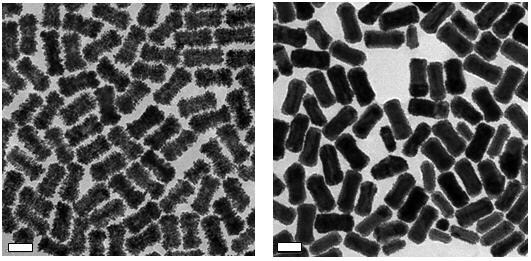
Figure 6. TEM images of Platinum coated gold nanostructures (Left) and Palladium coated gold nanostructures (Right). Scale bars are 50 nm.
Summary
The applications and types of gold nanoparticles have expanded significantly from the bulk aggregation response used in lateral flow assays (e.g. in pregnancy tests). Now their single nanoparticle properties are being used in biomedical, material, optical, and industrial applications. These materials are still being actively researched, and applications utilizing their enhanced photothermal capabilities and surface reactivities are only beginning to be realized.
References
如要继续阅读,请登录或创建帐户。
暂无帐户?